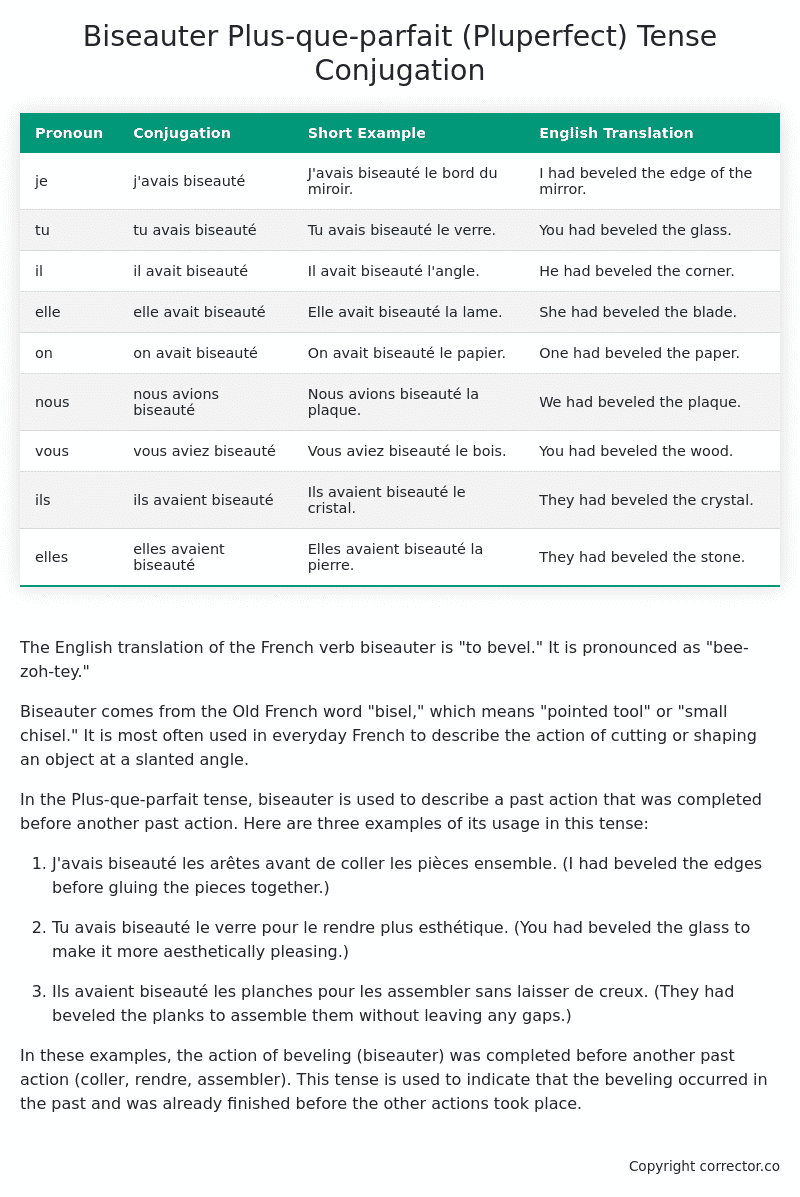Plus-que-parfait (Pluperfect) Tense Conjugation of the French Verb biseauter
Introduction to the verb biseauter
The English translation of the French verb biseauter is “to bevel.” It is pronounced as “bee-zoh-tey.”
Biseauter comes from the Old French word “bisel,” which means “pointed tool” or “small chisel.” It is most often used in everyday French to describe the action of cutting or shaping an object at a slanted angle.
In the Plus-que-parfait tense, biseauter is used to describe a past action that was completed before another past action. Here are three examples of its usage in this tense:
-
J’avais biseauté les arêtes avant de coller les pièces ensemble. (I had beveled the edges before gluing the pieces together.)
-
Tu avais biseauté le verre pour le rendre plus esthétique. (You had beveled the glass to make it more aesthetically pleasing.)
-
Ils avaient biseauté les planches pour les assembler sans laisser de creux. (They had beveled the planks to assemble them without leaving any gaps.)
In these examples, the action of beveling (biseauter) was completed before another past action (coller, rendre, assembler). This tense is used to indicate that the beveling occurred in the past and was already finished before the other actions took place.
Table of the Plus-que-parfait (Pluperfect) Tense Conjugation of biseauter
| Pronoun | Conjugation | Short Example | English Translation |
|---|---|---|---|
| je | j’avais biseauté | J’avais biseauté le bord du miroir. | I had beveled the edge of the mirror. |
| tu | tu avais biseauté | Tu avais biseauté le verre. | You had beveled the glass. |
| il | il avait biseauté | Il avait biseauté l’angle. | He had beveled the corner. |
| elle | elle avait biseauté | Elle avait biseauté la lame. | She had beveled the blade. |
| on | on avait biseauté | On avait biseauté le papier. | One had beveled the paper. |
| nous | nous avions biseauté | Nous avions biseauté la plaque. | We had beveled the plaque. |
| vous | vous aviez biseauté | Vous aviez biseauté le bois. | You had beveled the wood. |
| ils | ils avaient biseauté | Ils avaient biseauté le cristal. | They had beveled the crystal. |
| elles | elles avaient biseauté | Elles avaient biseauté la pierre. | They had beveled the stone. |
Other Conjugations for Biseauter.
Le Present (Present Tense) Conjugation of the French Verb biseauter
Imparfait (Imperfect) Tense Conjugation of the French Verb biseauter
Passé Simple (Simple Past) Tense Conjugation of the French Verb biseauter
Passé Composé (Present Perfect) Tense Conjugation of the French Verb biseauter
Futur Simple (Simple Future) Tense Conjugation of the French Verb biseauter
Futur Proche (Near Future) Tense Conjugation of the French Verb biseauter
Plus-que-parfait (Pluperfect) Tense Conjugation of the French Verb biseauter (this article)
Passé Antérieur (Past Anterior) Tense Conjugation of the French Verb biseauter
Futur Antérieur (Future Anterior) Tense Conjugation of the French Verb biseauter
Subjonctif Présent (Subjunctive Present) Tense Conjugation of the French Verb biseauter
Subjonctif Passé (Subjunctive Past) Tense Conjugation of the French Verb biseauter
Subjonctif Imparfait (Subjunctive Imperfect) Tense Conjugation of the French Verb biseauter
Subjonctif Plus-que-parfait (Subjunctive Pluperfect) Tense Conjugation of the French Verb biseauter
Conditionnel Présent (Conditional Present) Tense Conjugation of the French Verb biseauter
Conditionnel Passé (Conditional Past) Tense Conjugation of the French Verb biseauter
L’impératif Présent (Imperative Present) Tense Conjugation of the French Verb biseauter
L’infinitif Présent (Infinitive Present) Tense Conjugation of the French Verb biseauter
Struggling with French verbs or the language in general? Why not use our free French Grammar Checker – no registration required!
Get a FREE Download Study Sheet of this Conjugation 🔥
Simply right click the image below, click “save image” and get your free reference for the biseauter Plus-que-parfait tense conjugation!

Biseauter – About the French Plus-que-parfait (Pluperfect) Tense
Tense Formation
Common everyday usage patterns
Sequencing of past events
Background information
Hypothetical or reported speech
Interactions with other tenses
Summary
I hope you enjoyed this article on the verb biseauter. Still in a learning mood? Check out another TOTALLY random French verb conjugation!


